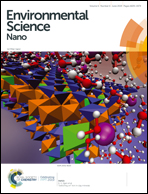Facet-mediated interaction between humic acid and TiO2 nanoparticles: implications for aggregation and stability kinetics in aquatic environments†
Abstract
Interfacial interactions between TiO2 nanocrystals and the surrounding environmental media play a critical role in dictating their environmental behaviors. Here two specific-faceted TiO2 crystals, {101} facet and {001} facet, were adopted to investigate facet-mediated aggregation kinetics in aquatic environments. In pristine electrolyte solution (NaCl and CaCl2), {001} TiO2 exhibited higher stability than {101} TiO2 due to the abundant –OH groups on the {001} facet surface. The presence of Suwannee river humic acid (SRHA) significantly improved the stability of TiO2 nanocrystals in a facet dependent manner, in which {101} TiO2 exhibited a more remarkable improvement in stability than {001} TiO2. At a high SRHA concentration (10 mg L−1), both faceted TiO2 displayed comparable stability. The adsorption experiments and attenuated total reflectance Fourier transformation infrared spectroscopy demonstrated that {101} TiO2 induced more pronounced adsorption of SRHA molecules than {001} TiO2, probably driven by the efficient bidentate coordination of –COO– groups in SRHA on the {101} facet. This facet-affected colloidal stability behavior would deepen our understanding on nanomaterial transport and exposure in natural waters.



 Please wait while we load your content...
Please wait while we load your content...